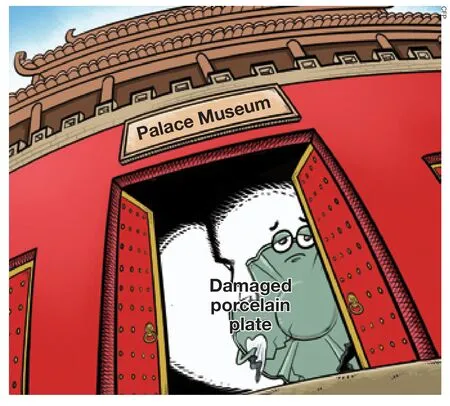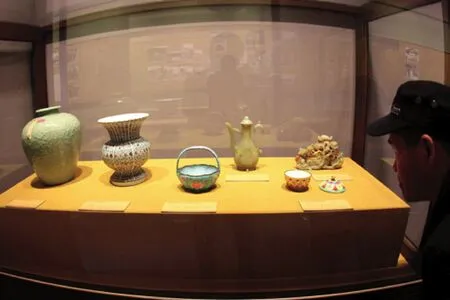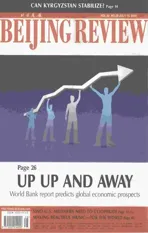Unpleasant Nights at The Museum
2010-10-14ByYUANYUAN
By YUAN YUAN
Unpleasant Nights at The Museum
By YUAN YUAN

A slew of scandals involving the Palace Museum has drawn attention to the plight of China’s public museums
The curator of Beijing’s Palace Museum, Zheng Xinmiao, has been a largely low-profile figure, and his name only became known to most average Chinese citizens after the Xinhua News Agency released an interview with him in August, in which Zheng apologized for a string of mishaps in the institution that houses the largest collection of China’s national treasures.
The Palace Museum, founded in 1925, is located in the Forbidden City, which served as the Chinese imperial palace in Ming (1368-1644) and Qing (1644-1911) dynasties.
The bad times for the museum began on May 8, when exhibition pieces on loan from a Hong Kong-based museum were stolen from the palace complex. In the following three months a series of scandals, from the damage of rare antiques by staff to an alleged attempt to cover up an embezzlement scam involving its security guards and tour guides,have hit the Palace Museum.
Response
The sheer number of scandals surrounding the Palace Museum have led the general public to lose faith in the management of Beijing’s most popular cultural heritage site.
“Perhaps they’ve covered up many similar mistakes before,” said a netizen known as Thinkid in a post on Sina Weibo, a twitterlike micro-blogging service in China.
Wu Zhengyuan, a Beijing resident, said in a blog post, “The Palace Museum is a world famous landmark containing numerous items that are thousands of years old. It is an important piece of heritage for foreign visitors and Chinese alike. But if no responsible staff can be found to properly take care of even these treasured items then frankly it’s dif fi cult to feel optimistic about China’s standing in the world.”
Many people suggested that those who are responsible for damaging these historical artifacts should be severely punished.
In the interview with Xinhua News Agency on August 20, Zheng admitted a 1,000-year-old porcelain masterpiece was broken by a researcher during tests in July, and he apologized for not informing the public earlier.
He admitted that July’s accident was the third caused by careless staff members over the past two years. Two ritual implements suffered damage in May 2004, and a fl ower receptacle was damaged in 2009.
He also said the museum had been offering monetary rewards for those who come forward with information that leads to the arrest of employees found cheating the museum out of ticket revenue.
Zheng pledged to upgrade the museum’s security system, and to enhance the level of care given to artifacts. He also promised more transparency and engagement with the public.
Concerns
Despite the recent scandals and growing public discontent, the Palace Museum is in fact in the throes of its largest ever renovation, which began in 2002. The total investment in the refurbishment will be 1.7 billion yuan ($266 million) and the project is expected to be completed by 2020.
According to the State Administration of Cultural Heritage, once refurbished the appearance of the Palace Museum will match the original appearance of the palace’s halls and buildings. Visitors will not only be able to admire the magni fi cent architecture and gorgeous imperial collection, they will also be able to see how the government of ancient dynasties operated, and what life was like inside and outside the court. Officials said the Palace Museum would no longer be simply a repository of relics, but an organic cultural entity.
A veteran Palace Museum expert who asked to remain anonymous failed to echo the officials’ enthusiasm. “The original structure of the imperial palace should be preserved in its entirety, such an enormous refurbishment project would be bound to cause damage. The construction will inevitably cause overall structural alterations.”
Possible changes to the imperial complex’s structures are not the only concerns related to the refurbishment. A blogger called Wuzini questioned if the 1.7 billion yuan would go to the right place. “Do they have a monitoring system to take care of this huge amount of money?” he said in a post.

CROWDED ENTRANCE: Visitors wait in long lines in front of the National Museum of China on March 27
Wuzini has grounds for concern. On August 17, a wall of the imperial Mountain Resort of the Qing Dynasty in Chengde,in Hebei Province, near Beijing, collapsed after heavy rain, raising questions about the use of maintenance funds. The 10-km wall was built in the 18th century and is part of a UNESCO-designated world heritage site.The Central Government allocated about 300 million yuan ($47 million) to repair the wall and the resort in 2010, but the wall simply slid off following heavy showers just a year later.
“Many major museums have become microcosms of inefficiency in China. If change can’t be brought about internally,it will be necessary to bring to bear some outside pressure for reform,” said Zhang Xiaoming, Deputy Director of the Cultural Research Center of the Chinese Academy of Social Sciences.
Loopholes
The Palace Museum
The Palace Museum was established in 1925. The magnificent architecture,also known as the Forbidden City, and the vast holding of the imperial collections of paintings, calligraphy, ceramics, and decorative objects make it one of the most prestigious museums in China and the world. In 1961 the imperial palace was designated by the State Council as one of China’s foremost-protected cultural heritage sites, and in 1987 was made a UNESCO World Heritage site.
According to an inventory of the museum’s collection conducted between 2004 and 2010, the Palace Museum holds a total of 1,807,558 artifacts and includes 1,684,490 items designated as nationally protected “valuable cultural relics.”
(Source:The Palace Museum)
According to Zhang, the biggest problem is that many museums are regarded by the public as closed and arrogant institutions with a lack of public participation in their affairs.
For example, the management of the Palace Museum has been roundly criticized for its poor attitude and excessive bureaucracy in handling the internal mishaps.
“Almost all the of fi cials in the museum are appointed by the government and I don’t think most of them are qualified to run the museum,” said Gao He, who retired from the Palace Museum in 1997.
Gao believes that the size of the museum’s management has expanded too fast and this expansion hasn’t done anything to improve overall efficiency. “When I left in 1997, there were only 10 departments, now there are more than 30,” he said.
But Wang Zhini, who graduated from Université d’Angers in France and works in the Marketing Department of the Palace Museum, said that she didn’t see the Palace Museum’s management as excessively arrogant. “They just don’t know how to communicate with the public,”Wang said.

COLLECTION OF WONDERS: Exhibits at the Palace Museum
“Museums are not government bureaus, nor warehouses for ancient stuff.They are public cultural institutions and transparency is very important,” said Song Xiangguang, a professor of archaeology at Peking University. “In fact the staff of the Palace Museum seem even lazier than some corrupt civil servants. And I bet many of them have none of the professional knowledge that is necessary for staff working in museums.”
Shang Yu, who used to work as a guide in the Palace Museum, claimed there were too many people working in the museum. “At least half of the workers don’t have serious work to do and even those who work every day are very lazy.”
Shang decided to quit her job at the Palace Museum in 2009 as she feared the pace of work in the Palace Museum would leave her unable to cope with the demands of the modern world. “I am still very young and I didn’t think the slow-paced job had any real prospects,” she said.
Pan Shouyong, a professor at the Minzu University of China, also attributes the frequency of damage to antiques to the fact that there are few professionals among museum workers.
According to a survey conducted by Pan, in 2008 and 2009, nearly 90 percent of museum employees in China did not have college degrees and very few of them had studied museum-related subjects. “The repeated occurrence of accidents in the Palace Museum shows that the workers there lack professionalism,” Pan said.
Statistics from the State Administration of Cultural Heritage show that the country’s museums now have 59,900 employees, of whom only 4.5 percent are well-trained technical personnel.
Even showpieces like the National Museum of China suffer from a lack of skilled professional staff.
In March 2011, the National Museum of China on the eastern side of the Tiananmen Square in central Beijing reopened to the public. While it opened to much fanfare as the largest museum in the world, visitors complained that their visits were less than satisfactory.
“We had to wait in long lines to get into the museum. Even though it was extremely hot, there was no protection from the sunshine,” said Li Chunhua, who came all the way from northeast China’s Heilongjiang Province to see the museum. “After we finally went in, it was also very hard to find chairs to rest in.”
“While the tickets are free we have to make reservations and the reservation numbers are either busy or nobody answers,”said a college student from Beijing Normal University. “There are no volunteers in the museum and it is hard to fi nd any brochures with information about the exhibitions at the entrance of the Museum.”
Tang Jigen, a researcher with the Chinese Academy of Social Sciences, said that his biggest concern is that due to a lack of professional knowledge, workers at museums don’t know how to properly protect the cultural relics they have collected.
“Currently, most public museum curators are appointed by the government. The result is that many museum curators are transferred from other unrelated political bureaus and manage museums in a similar way,” Tang said.
As public institutions, Tang suggested,public museums should have their curators elected by the public and curators should at least have a college degree in a related subject.

A MUST-SEE SITE: Visitors walk out of the Palace Museum’s Donghua Gate on July 20
